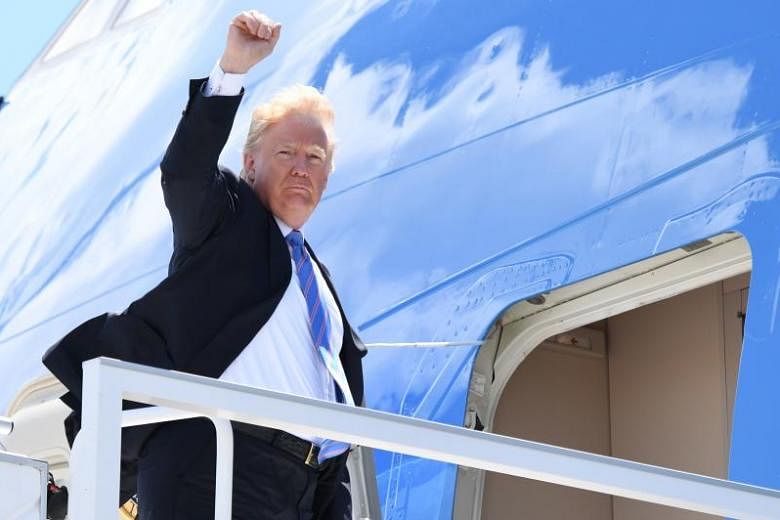PARIS (AFP) - US President Donald Trump's rejection of the text of a consensus statement at this weekend's G-7 summit comes after three months of escalating trade tensions between Washington and its partners.
Here are the key events in the standoff:
Trump threatens, EU responds
On March 1, 2018, Trump, who has made correcting his nation's trade deficit a priority, announces he intends to impose heavy tariffs on steel and aluminium imports.
The European Union responds by drawing up a hit list of flagship US products it could tax including Harley Davidson motorcycles, jeans, bourbon whiskey and peanut butter.
Heavy taxes
On March 8, Trump announces tariffs of 25 per cent on steel products and 10 percent on aluminium from March 23. He brushes aside warnings from allies on the risks of a trade war with unpredictable consequences.
He bases his move on a rarely used procedure in US trade legislation: article 232 which allows him to limit the import of certain products to protect national security.
Exemptions to May 1
On March 22, on the eve of the tariffs coming into force, Trump announces that they will be suspended until May 1 for the European Union.
Australia, Argentina, Brazil, and South Korea are also exempted, while Canada and Mexico are spared as they are part of the North American Free Trade Agreement (Nafta) trade bloc.
China is not exempted and announces tit-for-tat tariffs, slapping duties on US cars.
EU goes to WTO
On April 16, the EU follows China in complaining to the World Trade Organisation (WTO) over the tariffs.
Two days later, the EU's Trade Commissioner Cecilia Malmstrom calls for the bloc to be "permanently and unconditionally excluded from these measures". She says the EU will not negotiate with the US on trade issues otherwise.
On April 29, leaders of the EU's three largest economies - Britain, France and Germany - agree on the need to be "ready to react, if necessary, with efficiency and speed," to new tariffs.
Exemptions extended
On May 1, the US says it will extend for 30 days the exemptions from metals tariffs for Canada, Mexico and the EU.
The EU expresses disappointment, saying the decision would "prolong uncertainty," and calls for a permanent exemption.
Iran, automobile sector
On May 8, Trump withdraws from the Iran nuclear deal and threatens sanctions on foreign companies trading with Iran.
Ten days later, the EU tells the WTO it is ready to unfurl retaliatory measures against US tariffs on steel and aluminium, which would include European tariffs on motorcycles and bourbon.
On May 23, the White House announces it is considering possible tariffs on automobile imports, causing dismay in the EU, notably among German automakers.
Exemptions end
On May 31, the US says it will impose tough tariffs on steel and aluminium imports coming from the EU, Canada, Mexico.
The next day the EU and Canada file complaints at the WTO in response to the US tariffs, with Mexico on June 4 saying it would do the same.
G7 fiasco
On June 9 the G-7 summit ends in farce as Trump abruptly rejects the text of a joint communique approved by leaders and bitterly insults the Canadian host.
Trump's Twitter outburst from aboard Air Force One as he was leaving the meeting also included a more or less explicit renewal of his threat to impose sanctions on car imports.

